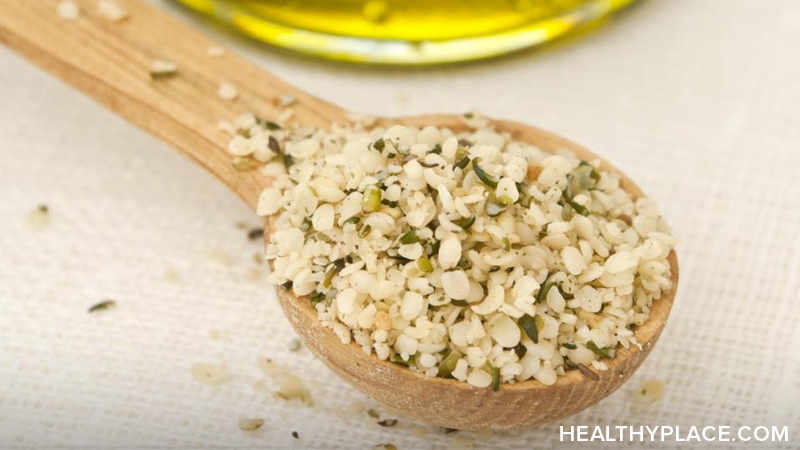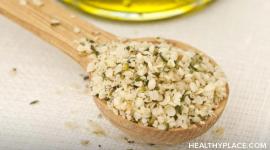Alpha-linolenic Acid (ALA)

Comprehensive information on ALA (Alpha-linolenic acid) for possible treatment of ADHD, eating disorders, depression, IBD, and heart disease. Learn about the usage, dosage, side-effects of ALA.
- Overview
- Uses
- Dietary Sources
- Available Forms
- How to Take It
- Precautions
- Possible Interactions
- Supporting Research
Overview
Alpha-linolenic acid, or ALA, is an essential fatty acid, which means that it is essential to human health but cannot be manufactured by the body. For this reason, ALA must be obtained from food. ALA, as well as the fatty acids eicosapentaenoic acid (EPA) and docosahexaenoic acid (DHA), belongs to a group of fatty acids called omega-3 fatty acids. EPA and DHA are found primarily in fish while ALA is highly concentrated in certain plant oils such as flaxseed oil and to a lesser extent, canola, soy, perilla, and walnut oils. ALA is also found in wild plants such as purslane. Once ingested, the body converts ALA to EPA and DHA, the two types of omega-3 fatty acids more readily used by the body.
It is important to maintain an appropriate balance of omega-3 and omega-6 (another essential fatty acid) in the diet as these two substances work together to promote health. These essential fats are both examples of polyunsaturated fatty acids, or PUFAs. Omega-3 fatty acids help reduce inflammation and most omega-6 fatty acids tend to promote inflammation. An inappropriate balance of these essential fatty acids contributes to the development of disease while a proper balance helps maintain and even improve health. A healthy diet should consist of roughly two to four times more omega-6 fatty acids than omega-3 fatty acids. The typical American diet tends to contain 11 to 30 times more omega-6 fatty acids than omega-3 fatty acids and many researchers believe this imbalance is a significant factor in the rising rate of inflammatory disorders in the United States.
Omega-3 fatty acids have been shown to reduce inflammation and help prevent certain chronic diseases such as heart disease and arthritis. These essential fatty acids are highly concentrated in the brain and appear to be particularly important for cognitive and behavioral function as well as normal growth and development.
Uses of ALA
Studies suggest that ALA and other omega-3 fatty acids may be helpful in treating a variety of conditions. The evidence is strongest for heart disease and problems that contribute to heart disease, but the range of possible uses for ALA include:
Alpha-linolenic Acid for Heart Disease
One of the best ways to help prevent and treat heart disease is to eat a low-fat diet and to replace foods rich in saturated and trans-fat with those that are rich in monounsaturated and polyunsaturated fats (particularly omega-3 fatty acids). In addition to reducing risk factors for heart disease, namely high blood pressure and elevated cholesterol, evidence suggests that people who eat an ALA-rich diet are less likely to suffer a fatal heart attack.
Alpha-linolenic Acid for High Cholesterol
People who follow a Mediterranean-style diet tend to have higher HDL ("good") cholesterol levels. This diet consists of a healthy balance between omega-3 and omega-6 fatty acids. It emphasizes whole grains, root and green vegetables, daily intake of fruit, fish and poultry, olive and canola oils, and ALA (found in flaxseed oil), along with discouragement of ingestion of red meat and total avoidance of butter and cream. In addition, walnuts (which are rich in ALA) have been shown to lower cholesterol and triglycerides in people with high cholesterol.
Alpha-linolenic Acid for High Blood Pressure
Several studies suggest that diets and/or supplements rich in omega-3 fatty acids (including ALA) lower blood pressure significantly in people with hypertension. Fish high in mercury (such as tuna) should be avoided, however, because they may increase blood pressure.
Alpha-linolenic Acid for Acne
Although there are few studies to support the use of omega-3 fatty acids for skin problems, many clinicians believe that flaxseed is helpful for treating acne.
Alpha-linolenic Acid for Arthritis
Several studies suggest that omega-3 fatty acid supplements reduce tenderness in joints, decrease morning stiffness, and improve mobility. Many people who take these supplements report that they do not need as much medicine to relieve their painful symptoms.
Alpha-linolenic Acid for Asthma
Preliminary research suggests that omega-3 fatty acid supplements (particularly perilla seed oil which is rich in ALA) may decrease inflammation and improve lung function in adults with asthma.
Alpha-linolenic Acid for Eating Disorders
Studies suggest that men and women with anorexia nervosa have lower than optimal levels of polyunsaturated fatty acids (including ALA and GLA). To prevent the complications associated with essential fatty acid deficiencies, some experts recommend that treatment programs for anorexia nervosa include PUFA-rich foods or supplements.
Alpha-linolenic Acid for Breast Cancer
Women who regularly consume foods rich in omega-3 fatty acids over many years may be less likely to develop breast cancer and to die from the disease than women who do not follow such a diet. This is particularly true among women who consume fish instead of meat. Laboratory and animal studies indicate that omega-3 fatty acids can inhibit the growth of human breast cancer cells and may even prevent the spread of cancer to other parts of the body. Several experts speculate that omega-3 fatty acids, in combination with other nutrients (namely, vitamin C, vitamin E, beta-carotene, selenium, and coenzyme Q10), may prove to be of particular value for preventing and treating breast cancer.
Alpha-linolenic Acid for Burns
Essential fatty acids have been used to reduce inflammation and promote wound healing in burn victims. Animal research indicates that omega-3 fatty acids help promote a healthy balance of proteins in the body -- protein balance is important for recovery after sustaining a burn. Further research is necessary to determine if this may apply to people as well.
Alpha-linolenic Acid for Inflammatory Bowel Disease (IBD)
Some people with Crohn's disease (CD), one form of IBD, have low levels of omega-3 fatty acids in their bodies. Evidence suggests that fish oil supplements containing omega-3 fatty acids may reduce symptoms of CD and ulcerative colitis (another inflammatory bowel disease), particularly if used in addition to medication. Preliminary animal studies have found that ALA may actually be more effective than EPA and DHA found in fish oil supplements, but further studies in humans are needed to confirm these findings.
Alpha-linolenic Acid for Depression
People who do not get enough omega-3 fatty acids or do not maintain a healthy balance of omega-3 to omega-6 fatty acids in their diet may be at an increased risk for depression. The omega-3 fatty acids are important components of nerve cell membranes. They help nerve cells communicate with each other, which is an essential step in maintaining good mental health.
Alpha-linolenic Acid for Menstrual Pain
In a study of nearly 200 Danish women, those with the highest dietary intake of omega-3 fatty acids had the mildest symptoms during menstruation.
Other - Alpha-linolenic Acid for ADHD
Although further research is needed, preliminary evidence suggests that omega-3 fatty acids may also prove helpful in protecting against certain infections and in treating a variety of conditions including ulcers, migraine headaches, attention deficit/hyperactivity disorder (ADHD), preterm labor, emphysema, psoriasis, glaucoma, Lyme disease, and panic attacks.
Dietary Sources of ALA
Dietary sources of ALA include flaxseeds, flaxseed oil, canola (rapeseed) oil, soybeans and soybean oil, pumpkin seeds and pumpkin seed oil, purslane, perilla seed oil, walnuts and walnut oil.
Available Forms
There are two types of commercial ALA preparations: cooking oils (including canola oil and soybean oil) and medicinal oils (including flaxseed oil and dietary supplements containing flaxseed oil).
Some manufacturing methods can destroy the nutrient value of products that contain ALA by exposing these oil-rich products to air, heat, or light. Generally, high-quality oil is bottled in light-resistant containers, refrigerated, and marked with an expiration date. All sources of omega-3 fatty acids are best kept refrigerated to protect the quality of the oil.
Be sure to buy ALA supplements made by established companies who certify that their products are free of heavy metals such as mercury.
How to Take ALA
The recommended adequate intake of ALA in the diet is listed below:
Pediatric
- Infants that are breastfed should receive sufficient amounts of ALA if the mother has an adequate intake of this fatty acid.
- Infant formula should contain 1.5% ALA.
Adult
- 2,200 mg/day of ALA
(100 grams of raw flaxseed provides 22,800 mg of ALA; 100 grams of dried butternuts provides 8,700 mg of ALA; 100 grams of English and Persian walnuts provides 6800 mg of ALA; 100 grams of cooked soybeans provides 2,100 mg of ALA)
Precautions
Because of the potential for side effects and interactions with medications, dietary supplements should be taken only under the supervision of a knowledgeable healthcare provider.
People with either diabetes or schizophrenia may lack the ability to convert ALA to EPA and DHA, the forms more readily used in the body. Therefore, people with these conditions should obtain their omega-3 fatty acids from dietary sources rich in EPA and DHA.
Although studies have found that regular consumption of fish (which includes the omega-3 fatty acids EPA and DHA) may reduce the risk of macular degeneration, a recent study including two large groups of men and women found that diets rich in ALA may substantially increase the risk of this disease. More research is needed in this area. Until this information becomes available, it is best for people with macular degeneration to obtain omega-3 fatty acids from sources of EPA and DHA, rather than ALA.
Similar to macular degeneration, fish and fish oil may protect against prostate cancer, but ALA may be associated with increased risk of prostate cancer in men. More research in this area is needed.
Possible Interactions
If you are currently being treated with any of the following medications, you should not use ALA without first talking to your healthcare provider.
Blood-thinning Medications
Omega-3 fatty acids may increase the blood-thinning effects of warfarin, aspirin, or other blood-thinning medications. While the combination of aspirin and omega-3 fatty acids may actually be helpful under certain circumstances (such as heart disease), they should only be taken together under the guidance and supervision of your healthcare provider.
Cholesterol-lowering Medications
Following certain nutritional guidelines, including increasing the amount of omega-3 fatty acids in your diet and reducing the omega-6 to omega-3 ratio, may allow a group of cholesterol lowering medications known as "statins" (such as atorvastatin, lovastatin, and simvastatin) to work more effectively.
Cyclosporine
Taking omega-3 fatty acids during cyclosporine therapy may reduce toxic side effects (such as high blood pressure and kidney damage) associated with this medication in transplant patients.
Nonsteroidal Anti-inflammatory Drugs (NSAIDs)
In an animal study, treatment with omega-3 fatty acids reduced the risk of ulcers from nonsteroidal anti-inflammatory drugs (NSAIDs). More research is needed to evaluate whether omega-3 fatty acids would have the same effects in people.
back to: Supplement-Vitamins Homepage
Supporting Research
Angerer P, von Schacky C. n-3 polyunsaturated fatty acids and the cardiovascular system. Curr Opin Lipidol. 2000;11(1):57-63.
Appel LJ. Nonpharmacologic therapies that reduce blood pressure: a fresh perspective. Clin Cardiol. 1999;22(Suppl. III):III1-III5.
Arnold LE, Kleykamp D, Votolato N, Gibson RA, Horrocks L. Potential link between dietary intake of fatty acid and behavior: pilot exploration of serum lipids in attention-deficit hyperactivity disorder. J Child Adolesc Psychopharmacol. 1994;4(3):171-182.
Baumgaertel A. Alternative and controversial treatments for attention-deficit/hyperactivity disorder. Pediatr Clin of North Am. 1999;46(5):977-992.
Belluzzi A, Boschi S, Brignola C, Munarini A, Cariani C, Miglio F. Polyunsaturated fatty acids and inflammatory bowel disease. Am J Clin Nutr. 2000;71(suppl):339S-342S.
Billeaud C, Bougle D, Sarda P, et al. Effects of preterm infant formula supplementation with alpha-linolenic acid with a linoleate/alpha-linolenate ratio of 6: a multicentric study. Eur J Clin Nutr. August 1997;51:520 - 527.
Boelsma E, Hendriks HF, Roza L. Nutritional skin care: health effects of micronutrients and fatty acids. Am J Clin Nutr. 2001;73(5):853-864.
Brinker F. Herb Contraindications and Drug Interactions. 2nd ed. Sandy, Ore: Eclectic Medical; 1998:71-72.
Brown DJ, Dattner AM. Phytotherapeutic approaches to common dermatologic conditions. Arch Dermatol. 1998;134:1401-1404.
Bruinsma KA, Taren DL. Dieting, essential fatty acid intake, and depression. Nutr Rev. 2000;58(4):98-108.
Burgess J, Stevens L, Zhang W, Peck L. Long-chain polyunsaturated fatty acids in children with attention-deficit hyperactivity disorder. Am J Clin Nutr. 2000; 71(suppl):327S-330S.
Caron MF, White CM. Evaluation of the antihyperlipidemic properties of dietary supplements. Pharmacotherapy. 2001;21(4):481-487.
Cho E, Hung S, Willett WC, et al. Prospective study of dietary fat and the risk of age-related macular degeneration. Am J Clin Nutr. 2001;73(2):209-218.
Curtis CL, Hughes CE, Flannery CR, Little CB, Harwood JL, Caterson B. N-3 fatty acids specifically modulate catabolic factors involved in articular cartilage degradation. J Biol Chem. 2000;275(2):721-724.
Danao-Camara TC, Shintani TT. The dietary treatment of inflammatory arthritis: case reports and review of the literature. Hawaii Med J. 1999;58(5):126-131.
DeDeckere EA, Korver O, Verschuren PM, Katan MB. Health aspects of fish and n-3 polyunsaturated fatty acids from plant and marine origin. Eur J Clin Nutr. 1998;52:749 - 753.
de Lorgeril M, Renaud S, Mamelle N, et al. Mediterranean alpha-linolenic acid-rich diet in secondary prevention of coronary heart disease. Lancet. 1994;343:1454 - 1459.
de Logeril M, Salen P, Martin JL, Monjaud I, Delaye J, Mamelle N. Mediterranean diet, traditional risk factors, and the rate of cardiovascular complications after myocardial infarction: final report of the Lyon Diet Heart Study. Circulation. 1999;99(6):779-785.
De-Souza DA, Greene LJ. Pharmacological nutrition after burn injury. J Nutr. 1998;128:797-803.
Deutch B. Menstrual pain in Danish women correlated with low n-3 polyunsaturated fatty acid intake. Eur J Clin Nutr. 1995;49(7):508-516.
Dichi I, Frenhane P, Dichi JB, et al. Comparison of omega-3 fatty acids and sulfasalazine in ulcerative colitis. Nutrition. 2000;16:87-90.
Edwards R, Peet M, Shay J, Horrobin D. Omega-3 polyunsaturated fatty acid levels in the diet and in red blood cell membranes of depressed patients. J Affect Disord. 1998;48:149 - 155.
Frieri G, Pimpo MT, Palombieri A, et al. Polyunsaturated fatty acid dietary supplementation: an adjuvant approach to treatment of Helicobacter pylori infection. Nutr Res. 2000;20(7):907-916.
Geerling BJ, Badart-Smook A, van Deursen C, et al. Nutritional supplementation with N-3 fatty acids and antioxidants in patients with Crohn's disease in remission: effects on antioxidant status and fatty acid profile. Inflamm Bowel Dis. 2000;6(2):77-84.
Geerling BJ, Houwelingen AC, Badart-Smook A, StockbrÃÂ ¼gger RW, Brummer R-JM. Fat intake and fatty acid profile in plasma phospholipids and adipose tissue in patients with Crohn's disease, compared with controls. Am J Gastroenterol. 1999;94(2):410-417.
GISSI-Prevenzione Investigators. Dietary supplementation with n-3 polyunsaturated fatty acids and vitamin E after myocardial infarction: results of the GISSI-Prevenzione trial. Lancet. 1999;354:447-455.
Harper CR, Jacobson TA. The fats of life: the role of omega-3 fatty acids in the prevention of coronary heart disease. Arch Intern Med. 2001;161(18):2185-2192.
Harris WS. N-3 fatty acids and serum lipoproteins: human studies. Am J Clin Nutr. 1997;65:1645S-1654S .
Hayashi N, Tsuguhiko T, Yamamori H, et al. Effect of intravenous omega-6 and omega-3 fat emulsions on nitrogen retention and protein kinetics in burned rats. Nutrition. 1999;15(2):135-139.
Hibbeln JR, Salem N, Jr. Dietary polyunsaturated fatty acids and depression: when cholesterol does not satisfy. Am J Clin Nurt. 1995;62(1):1-9.
Horrobin DF. The membrane phospholipid hypothesis as a biochemical basis for the neurodevelopmental concept of schizophrenia. Schizophr Res. 1998;30(3):193-208.
Horrobin DF, Bennett CN. depression and bipolar disorder: relationships to impaired fatty acid and phospholipid metabolism and to diabetes, cardiovascular disease, immunological abnormalities, cancer, ageing and osteoporosis. Prostaglandins Leukot Essent Fatty Acids. 1999;60(4):217-234.
Hrboticky N, Zimmer B, Weber PC. Alpha-Linolenic acid reduces the lovastatin-induced rise in arachidonic acid and elevates cellular and lipoprotein eicosapentaenoic and docosahexaenoic acid levels in Hep G2 cells. J Nutr Biochem. 1996;7:465-471.
Hu FB, Stampfer MJ, Manson JE et al. Dietary intake of alpha-linolenic acid and risk of fatal ischemic heart disease among women. Am J Clin Nutr. 1999;69:890-897.
The International Society for the Study of Fatty Acids and Lipids (ISSFAL). Recommendations for the essential fatty acid requirement for infant formulas (policy statement). Available at: http://www.issfal.org.uk/. Accessed January 17, 2001.
Jeschke MG, Herndon DN, Ebener C, Barrow RE, Jauch KW. Nutritional intervention high in vitamins, protein, amino acids, and omega-3 fatty acids improves protein metabolism during the hypermetabolic state after thermal injury. Arch Surg. 2001;136:1301-1306.
Juhl A, Marniemi J, Huupponen R, Virtanen A, Rastas M, Ronnemaa T. Effects of diet and simvastatin on serum lipids, insulin, and antioxidants in hypercholesterolemic men; a randomized controlled trial. JAMA. 2002;2887(5):598-605.
Krauss RM, Eckel RH, Howard B, Appel LJ, Daniels SR, Deckelbaum RJ, et al. AHA Scientific Statement: AHA dietary guidelines revision 2000: A statement for healthcare professionals from the nutrition committee of the American Heart Association. Circulation. 2000;102(18):2284-2299.
Kremer JM. N-3 fatty acid supplements in rheumatoid arthritis. Am J Clin Nutr. 2000;(suppl 1):349S-351S.
Kris-Etherton P, Eckel RH, Howard BV, St. Jeor S, Bazzare TL. AHA science advisory: Lyon diet heart study. Benefits of a Mediterranean-style, National Cholesterol Education Program/American Heart Association Step I dietary pattern on cardiovascular disease. Circulation. 2001;103:1823-1825.
Kris-Etherton PM, Taylor DS, Yu-Poth S, et al. Polyunsaturated fatty acids in the food chain in the United States. Am J Clin Nutr. 2000;71(1 Suppl):179S-188S.
Kuroki F, Iida M, Matsumoto T, Aoyagi K, Kanamoto K, Fujishima M. Serum n3 polyunsaturated fatty acids are depleted in Crohn's disease. Dig Dis Sci. 1997;42(6):1137-1141.
Lockwood K, Moesgaard S, Hanioka T, Folkers K. Apparent partial remission of breast cancer in 'high risk' patients supplemented with nutritional antioxidants, essential fatty acids, and coenzyme Q10. Mol Aspects Med. 1994;15Suppl:s231-s240.
Lorenz-Meyer H, Bauer P, Nicolay C, Schulz B, Purrmann J, Fleig WE, et al. Omega-3 fatty acids and low carbohydrate diet for maintenance of remission in Crohn's disease. A randomized controlled multicenter trial. Study Group Members (German Crohn's Disease Study Group). Scan J Gastroenterol. 1996;31(8):778-785.
McGuffin M, Hobbs C, Upton R, et al, eds. Botanical Safety Handbook. Boca Raton, FL: CRC Press; 1997.
Mayser P, Mrowietz U, Arenberger P, Bartak P, Buchvald J, Christophers E, et al. Omega-3 fatty acid-based lipid infusion in patients with chronic plaque psoriasis: results of a double-blind, randomized, placebo controlled, multicenter trial. J Am Acad Dermatol. 1998;38(4):539-547.
Mitchell EA, Aman MG, Turbott SH, Manku M. Clinical characteristics and serum essential fatty acid levels in hyperactive children. Clin Pediatr (Phila). 1987;26:406-411.
Nestel PJ, Pomeroy SE, Sasahara T, et al. Arterial compliance in obese subjects is improved with dietary plant n-3 fatty acid from flaxseed oil despite increased LDL oxidizability. Arterioscler Thromb Vasc Biol. July 1997;17(6):1163-1170.
Newcomer LM, King IB, Wicklund KG, Stanford JL. The association of fatty acids with prostate cancer risk. Prostate. 2001;47(4):262-268.
Okamoto M, Misunobu F, Ashida K, Mifune T, Hosaki Y, Tsugeno H, et al. Effects of dietary supplementation with n-3 fatty acids compared with n-6 fatty acids on bronchial asthma. Int Med. 2000;39(2):107-111.
Okamoto M, Misunobu F, Ashida K, Mifune T, Hosaki Y, Tsugeno H et al. Effects of perilla seed oil supplementation on leukotriene generation by leucocytes in patients with asthma associated with lipometabolism. Int Arch Allergy Immunol. 2000;122(2):137-142.
Prasad K. Dietary flaxseed in prevention of hypercholesterolemic atherosclerosis. Atherosclerosis. 1997;132(1):69 - 76.
Prisco D, Paniccia R, Bandinelli B, et al. Effect of medium term supplementation with a moderate dose of n-3 polyunsaturated fatty acid on blood pressure in mild hypertensive patients. Thromb Res. 1998;91:105-112.
Richardson AJ, Puri BK. The potential role of fatty acids in attention-deficit/hyperactivity disorder. Prostaglandins Leukot Essent Fatty Acids. 2000;63(1/2):79-87.
Shils ME, Olson JA, Shike M, Ross AC. Modern Nutrition in Health and Disease. 9th ed. Baltimore, Md: Williams & Wilkins; 1999:90-92, 1377-1378.
Shoda R, Matsueda K, Yamato S, Umeda N. Therapeutic efficacy of N-3 polyunsaturated fatty acid in experimental Crohn's disease. J Gastroenterol. 1995;30(Suppl 8):98-101.
Simopoulos AP. Essential fatty acids in health and chronic disease. Am J Clin Nutr. 1999;70(30 Suppl):560S-569S.
Simopoulos AP. Human requirement for N-3 polyunsaturated fatty acids. Poult Sci. 2000;79(7):961-970.
Soyland E, Funk J, Rajka G, Sandberg M, Thune P, Ruistad L, et al. Effect of dietary supplementation with very-long chain n-3 fatty acids in patients with psoriasis. NEJM. 1993;328(25):1812-1816.
Stampfer MJ, Hu FB, Manson JE, Rimm EB, Willett WC. Primary prevention of coronary heart disease in women through diet and lifestyle. NEJM. 2000;343(1):16-22.
Stevens LJ, Zentall SS, Abate ML, Kuczek T, Burgess JR. Omega-3 fatty acids in boys with behavior, learning and health problems. Physiol Behav. 1996;59(4/5):915-920.
Stoll BA. Breast cancer and the Western diet: role of fatty acids and antioxidant vitamins. Eur J Cancer. 1998;34(12):1852-1856.
Talom RT, Judd SA, McIntosh DD, et al. High flaxseed (linseed) diet restores endothelial function in the mesenteric arterial bed of spontaneously hypertensive rats. Life Sci. 1999;16:1415 - 1425.
Terry P, Lichtenstein P, Feychting M, Ahlbom A, Wolk A. Fatty fish consumption and risk of prostate cancer. Lancet. 2001;357(9270):1764-1766.
Tsujikawa T, Satoh J, Uda K, Ihara T, Okamoto T, Araki Y, et al. Clinical importance of n-3 fatty acid-rich diet and nutritional education for the maintenance of remission in Crohn's disease. J Gastroenterol. 2000;35(2):99-104.
von Schacky C, Angere P, Kothny W, Theisen K, Mudra H. The effect of dietary omega-3 fatty acids on coronary atherosclerosis: a randomized, double-blind, placebo-controlled trial. Ann Intern Med. 1999;130:554-562.
Voskuil DW, Feskens EJM, Katan MB, Kromhout D. Intake and sources of alpha-linolenic acid in Dutch elderly men. Eur J Clin Nutr. 1996;50:784 - 787.
Yehuda S, Rabinovitz S, Carasso RL, Mostofsky DI. Fatty acids and brain peptides. Peptides. 1998;19:407 - 419.
Zambón D, Sabate J, Munoz S, et al. Substituting walnuts for monounsaturated fat improves the serum lipid profile of hypercholesterolemic men and women. Ann Intern Med. 2000;132:538-546.
back to: Supplement-Vitamins Homepage
APA Reference
Staff, H.
(2008, December 30). Alpha-linolenic Acid (ALA), HealthyPlace. Retrieved
on 2024, June 20 from https://www.healthyplace.com/alternative-mental-health/supplements-vitamins/alpha-linolenic-acid-ala



